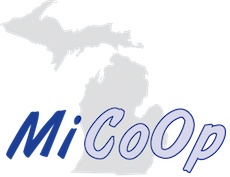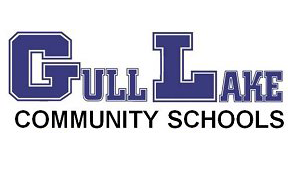Graduating Leaders
Gull Lake Community Schools (GLCS) encompasses 154 square miles covering three counties between Kalamazoo and Battle Creek. Over 4,000 PK-13 students from a wide range of economic backgrounds are enrolled with GLCS. According to the US Census Bureau, Richland, MI had a median household income of $87,008 in 2019 with fifty percent of the population holding a bachelor’s degree or higher. While a large percentage of the Gull Lake community are middle- and upper-class residents, 26% of the students at Gull Lake Community Schools are economically disadvantaged.
The mission of Gull Lake Community Schools is to educate every child to the best of his/her ability. To meet the wide range of student/family needs, GLCS provides a variety of program enrollment options. These programs include a traditional PK-12, an alternative school, an early college, and a virtual partnership. Every child, regardless of the program selected, is a Gull Lake student and can design their education from one or more of these programs. Many students blend their education within these programs. For example, a student may take three Gull Lake High School courses, dual enroll in two courses at the college, and take a virtual partnership course while another student may attend the partnership and enroll in nursing classes at Western Michigan University. Once enrolled in GLCS, students are provided a rigorous, personalized experience through a variety of choices.
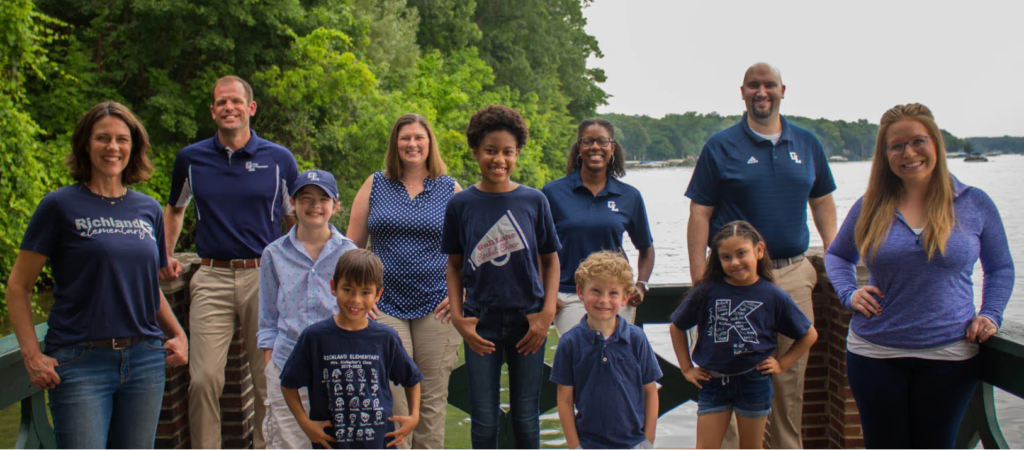
PC: GLCS website
Gull Lake has been on the forefront of educational innovation for many years as they were among the first to try new initiatives including all-day kindergarten, 1:1 devices for students, the virtual school, an early college, and K-12 Spanish. Gull Lake’s innovation journey also includes a partnership with home school families that enroll part-time. This partnership has expanded overall district programming. Robotics and fencing began at the partnership and are now woven into the traditional school course offerings. As students, families, staff, and the community become more familiar with the ability for students to choose from a variety of options in their learning, more blending of programs has occurred.
This blending of programs can be attributed, in part, to Gull Lakes’ commitment to Multi-Tier System of Supports (MTSS). The focal point of MTSS is student learning. Gull Lake provides academic, social, emotional, and behavioral supports and interventions to every learner, whether struggling or advanced, so they can be successful. Because the focus is on students and learning, a variety of flexible educational options is offered. Based on the MTSS model, Gull Lake supports student learning with great leadership, a culture of trust and empowerment, and professional development. GLCS provides district-wide professional development, aligned to their school improvement plan, through personal learning communities (PLCs), and other opportunities and resources. Continual school improvement through data-driven decisions has changed the way the district works and collaborates together.
As with other innovative districts, it’s the school board and superintendent that guide and support the change that happens. Chris Rundle, Superintendent of Gull Lake Community Schools, believes the board is the most important part of their innovation journey. Without their support, innovative, personalized initiatives prompted by the staff, families, or community would not be possible. In addition to giving kudos to the board, Chris credits the staff for the district’s growth in student-centered learning. “Gull Lake has an excellent, creative, and innovative staff that puts kids first.” This mutual respect and drive by the board, superintendent, and staff create a culture of innovation leading to student success.
GLCS’s innovation goes beyond its district. During the COVID pandemic, GLCS was instrumental in building collaboration between districts in the county. To provide quality online courses with experienced teachers for students at home, the ISD (KRESA – Kalamazoo Regional Educational Service Agency) created the KRESA Virtual & Innovative Collaborative (KVIC). Students remained in their district with local teacher mentors and Gull Lake’s experienced virtual teachers taught the courses.
The following information highlights ways in which Gull Lake is personalizing education for students. While the format for this article separates the initiatives by program enrollment options, students at Gull Lake can blend their learning between programs. This inclusiveness culminates at graduation where students from many of the programs walk across the stage together.
Innovation and Personalization in the Traditional School Structure
Gull Lake Community Schools creates a college-going culture for all students from the time they enroll until they graduate. At every level, Gull Lake:
- reviews school improvement plans and makes adjustments yearly.
- aligns curriculum to state standards.
- uses data to drive college readiness policies by benchmark testing and progress monitoring.
- works to engage families in supporting their child’s educational journey to adulthood.
Elementary Schools
Preparing kids for success begins at Gull Lake’s three elementary schools, Kellogg Elementary (PK-2nd grade), Richland Elementary (Y5-2nd grade), and Ryan Intermediate (3rd-5th grade). As with all Gull Lake programs, student data drives instruction for continuous improvement at the elementary level. Data is gathered from their Core Reading Program, Acadiance (previously DIBELS), Delta CBM, STAR, NWEA MAP, M-STEP, and SWIS. The data is analyzed regularly and changes are made in instruction to improve student learning. Other components that assist in Gull Lake’s elementary school improvement are math/reading learning labs, after-school and summer programs, counselors and social workers on staff, a partnership with Big Brothers/Big Sisters, and systems like positive behavior support and Response to Intervention (RTI).
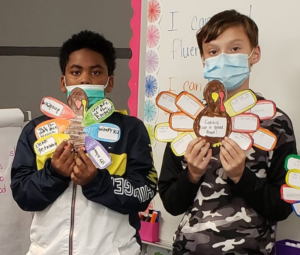
PC: GLCS website
ExCEL (Explorations in Critical Thinking to Enhance Learning) is an academic enrichment program available for the top 10-15% of students in each grade, 1st-5th, to personalize education for this population. Students meet with an instructor for 50 minutes per week in this extension program. The activities offered are in addition to their regular classroom curriculum and challenge students to think critically, read at a higher level, research, and more.
The staff at Ryan Intermediate creates a school culture where all children are empowered to be leaders. This change in thinking centers around believing that every child is capable of leading. Through the Leader in Me process, students learn the 7 habits of happy kids and how those leadership and life skills will equip them to be successful leaders in whatever path life takes them. Leadership training is woven into daily activities so that these skills become part of the students’ lives. Every student also has more than 15 opportunities to sign up for a leadership role at the school. These roles include the Greeter Team, Kindness Club Team, Behavior Celebrations Team, Lost and Found Team, and many others.
Instead of seeing children through the lens of a normal distribution curve—some kids are naturally smart and others are not—The Leader in Me paradigm sees that every child is capable, every child is a leader. This paradigm changes everything. ~The Leader in Me website
In 2021, the district began using the Project Lead the Way (PLTW) Launch curriculum for the 3rd-5th grade students at Ryan Intermediate. Through this curriculum, students tackle real-world problems in their new Science, Technology, Engineering, Art/Architecture, and Math (STEAM) Lab. They apply engineering practices and design thinking, and learn how to collaborate, problem solve, and think critically and creatively as they work on their projects.
Gull Lake elementary schools build a strong learning foundation for students that prepares them for the next step in their education journey. Analyzing student data empowers the staff to personalize programs and supports through technology and other learning options.
Middle School
Gull Lake Middle School (GLMS) houses students in grades 6th-8th. Through the Positivity Project, which takes place during advisory, students at GLMS are building positive relationships. They learn a common vocabulary and ways to practice the 24 Positivity Project character strengths. This ongoing project helps students become more self-aware and gain self-confidence. They also begin to understand and appreciate each other which in turn strengthens the culture of the school.
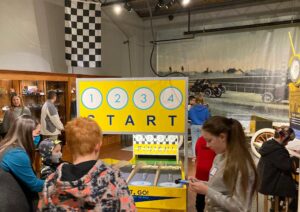
Project-based learning at Gilmore Museum. PC: GLCS Facebook page
In addition to building a strong culture, GLMS believes in personalizing learning to ensure each student reaches his/her full potential. Every student at the middle school receives a school Chromebook to access platforms and tools that support their learning progression. Students use this device to access their Google classroom materials, take online courses, and use digital media and software to remediate, extend, or accelerate their learning.
The curriculum at the middle school that allows students to find their passions includes Project Lead the Way (PLTW), virtual course options, band, choir, student senate, and yearbook. Students start career development in 6th grade. While in middle school, students also begin using Xello to develop an educational development plan that they continue to adjust in high school and as they learn more about themselves, careers, and life in general. All students in 8th grade take the PSAT and have the opportunity to take classes such as Algebra I, ELA 9, Spanish I, and PLTW Computer Science for high school credit if they meet qualifying criteria. From 2018 to 2021, Gull Lake Middle School received the PLTW Gateway Distinguished School award.
Supports to help students on their learning continuum in the middle school include
- the Reaching & Teaching Struggling Learners (RTSL) class which implements the Why Try curriculum focused on building self awareness and resilience skills.
- an ELA and Math Lab for remediation and additional support with on grade level standards.
- a guided study course focused on executive functioning, organization, and supporting sixth graders in the transition to middle school.
- Friday advisory small groups focused on literacy.
- an after school homework lab.
- counselors and social workers on staff.
- at-risk interventions.
- positive behavior supports.
- a gatekeeper program in 7th grade for social and emotional support.
The programs and supports available at GLMS prepare students for the educational opportunities at the high school as well as develop skills to be successful in careers and life.
High School
Like other buildings in the district, Gull Lake High School (GLHS) facilitates personal learning communities, exposes students to skill-building activities, provides accelerated and extended learning opportunities, and delivers support for all students, especially those at-risk. Counselors have a toolbox of options to offer students to personalize their education. There is also a strong emphasis on meaningful educational development plans and every student meets yearly with their counselor to discuss their unique plan. Many 10th graders choose to take the College and Career Readiness course where they research colleges, explore careers, and develop employability skills.
High school students have many options to choose from when building their learning path.
- A wide variety of elective in-person courses in the high school building
- College courses through the Gull Lake Early College program
- Virtual courses through the Gull Lake Virtual Partnership
- Career & Technical Education (CTE) and Education for the Arts courses through Kalamazoo Regional Educational Service Agency
- Kalamazoo Area Math and Science Center courses through Kalamazoo Public Schools
Virtual course offerings are popular with Gull Lake high school students. A virtual lab is open every hour of every day and is supervised by a GLHS teacher/mentor who monitors Gull Lake High School students taking online courses. Due to the processes, procedures, and relationships built, students taking online courses at GLHS have a high rate of success for completing their coursework.
High school students can also dual enroll or take AP courses to gain college credit. Most dual enrollment courses are offered off-site at local colleges. A minimum of ten AP courses are offered at GLHS every year. Of the 209 AP exams taken in 2021, 51% had scores of 3 or higher. Gull Lake High School has been recognized by the College Board as an AP Honor Roll school for increased enrollment in AP courses and continued improvement on AP exam scores. Another option for college credit is Gull Lake’s Early College program (see the Gull Lake Virtual Partnership and Early College section below).
In the Spring of 2018, the Gull Lake community passed a bond that included a high school performing arts center. This long-awaited performance venue, opening in Spring 2022, will be used for K-12 student presentations, band festivals, theatre classes, plays, and will boast an art gallery walk area. External performers like those scheduled at Western Michigan University or the Kalamazoo Fine Arts Center will be brought to Gull Lake by the fine arts manager hired to oversee the activities of the center. This facility opens the door for additional personalized learning opportunities at Gull Lake.
One of Gull Lake’s most innovative programs at the high school is its Computer Science program. (Computer Science is an EFE program so any student in KRESA can take these courses.) The Computer Science program consists of Intro to Computer Science, Computer Science Software Engineering (CSSE), Advanced Computer Science, Research and Development, Cyber Security, and Advanced Cyber Security. Throughout the program, Brad Lange, High School Technology Teacher, mentors students through frustration, failure, and success.
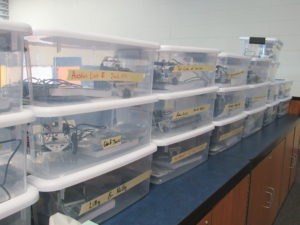 In ninth-grade, students may take the Intro to Computer Science class. In this class, they are introduced to computer programming as they learn the language Python and learn how to develop apps. Students who are interested in this type of work usually take the CSSE class. In CSSE, students work in teams to develop computational thinking and solve problems using a variety of programming languages including C+, hardware such as Arduino boards, and software like Tinkercad.
In ninth-grade, students may take the Intro to Computer Science class. In this class, they are introduced to computer programming as they learn the language Python and learn how to develop apps. Students who are interested in this type of work usually take the CSSE class. In CSSE, students work in teams to develop computational thinking and solve problems using a variety of programming languages including C+, hardware such as Arduino boards, and software like Tinkercad.
The CSSE course begins with a Boe-Bot unit. In this unit, students build a robot and program it to perform basic maneuvers such as drive in a straight line and turn 90 degrees right or left. Students learn to be accurate programmers through testing. When they say, “That’s close enough,” Brad asks them, “If your family was in that self-driving car, would ‘close enough’ be okay?” Following the build-and-test phase, groups design a maze (track) and program the robot to follow that track. In addition to the codes already learned, they write new ones for speeding up and slowing down. Groups compete with one another to see whose robot can perform the best based on an accuracy rubric. Patience and persistence are learned through this iterative process as the robot often doesn’t perform as the students thought it would. A lot of math and basic coding skills are also learned as they reprogram and test again.
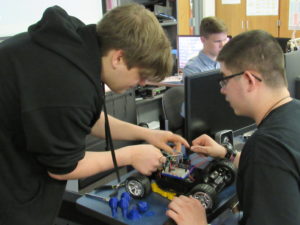 Once students complete the Python program and master Boe-Bots, they move to Arduino boards which are used to build electronics projects. Arduino boards consist of circuit boards attached to IDE (Integrated Development Environment) software on a computer which sends code (i.e., directions) to the board. Student teams go through 10 tutorials in Autodesk, a software program that simulates an Arduino board, before receiving an actual board. Projects vary but may include turning lights or switches on/off and taking pictures. Once they prove they can successfully use a virtual Arduino board, students then physically create what they designed. The final project is a Ted Talk video where students explain how they came up with their idea for the project, show the hardware components used, elaborate on the code, and present what the Arduino board actually does. The videos are put on a YouTube channel or Google Videos for others to view. When students have questions during the entire process, they are required to search Google for an answer and ask three other teams before they can ask their teacher for help. Brad’s facilitation role in this process is important as it is consistent to what students will encounter in this career field. “It’s great to hear the students say, ‘Holy cow! I did it! And see them giving high fives when they are successful,” shared Brad. Some students were so interested in Arduino that they created a webpage, Arduino Project, about it.
Once students complete the Python program and master Boe-Bots, they move to Arduino boards which are used to build electronics projects. Arduino boards consist of circuit boards attached to IDE (Integrated Development Environment) software on a computer which sends code (i.e., directions) to the board. Student teams go through 10 tutorials in Autodesk, a software program that simulates an Arduino board, before receiving an actual board. Projects vary but may include turning lights or switches on/off and taking pictures. Once they prove they can successfully use a virtual Arduino board, students then physically create what they designed. The final project is a Ted Talk video where students explain how they came up with their idea for the project, show the hardware components used, elaborate on the code, and present what the Arduino board actually does. The videos are put on a YouTube channel or Google Videos for others to view. When students have questions during the entire process, they are required to search Google for an answer and ask three other teams before they can ask their teacher for help. Brad’s facilitation role in this process is important as it is consistent to what students will encounter in this career field. “It’s great to hear the students say, ‘Holy cow! I did it! And see them giving high fives when they are successful,” shared Brad. Some students were so interested in Arduino that they created a webpage, Arduino Project, about it.
Another unit in CSSE is virtual machines. A virtual machine is software the students install on their school computer that allows them to set up other operating systems like Windows and Linux on that computer. Students can then “enter” one of the other virtual machines to install, update, and test the operating system. They can set up users and security features, create viruses to see how they affect the operating system, install anti-virus programs, and perform malware checks. This testing and learning about other operating systems using a virtual machine can be done without affecting the actual operating system of their school computer.
Like many employees at major companies such as Google and 3M, CSSE students spend 20% of their time being innovative. On Fridays throughout the school year, students work independently or in small teams on a research and design project. From idea generation to design to implementation, students are in charge of their own learning which includes researching and learning programs not taught as part of the regular course. Brad is available as a resource and ensures that students are on task and making progress, but he also allows students to make mistakes and fail. Students are required to create a website that shows their research and development. At the end of the year, students showcase their projects in the high school media center on Innovation Day. In addition to district staff and students, attendees at this gallery-walk style event include representatives from major corporations in the area.
On Fridays, the 3D printer runs non-stop. Students use Tinkercad software to design chess pieces, cryptex, and various parts for other projects. Most of the students designing video games used a free version of Unity, a platform for game design. Students learn the software on their own by watching tutorials, reading documentation, and talking with one another. One student in the class built his own personal computer that could use multiple keyboards, mice, and screens at one time. When he got it to work, he was overheard saying, “I’m so proud of this!”
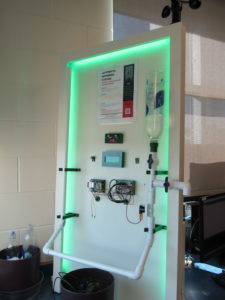
Automatic watering system
Research and development projects completed by students fall into a variety of categories showcasing the various interests of the students: Video Game Design, Arduino Boards, 3D Printer, Music, Phone & Tablet Applications, Computer Programming, Graphic Design, Computer Build, and Social Media. One project completed was an automatic watering system. Throughout this project, the student learned electronics, programming languages, and 3D printing as well as research skills, product testing, patience, and persistence.
After CSSE, students can choose to take the Research and Development class, Cyber Security, or go into the Advanced Computer Science class. Advanced Computer Science is more targeted toward programming/coding. Students learn JAVA programming and use Android Studio for app development. The Research and Development class covers anything under the STEM umbrella. Students can retake the course to continue working on a project or try something new. Brad is always “excited to see what the students come up with when they have five days a week to tinker and learn.” In Cyber Security, students work in teams of up to six and learn how to find cyber security vulnerabilities within an operating system code. They compete in a virtual competition, CyberPatriot, with other schools/groups from around the country.
While the Computer Science program is one way in which Gull Lake continues to be innovative and personalizes learning for their students, GLHS also provides a variety of course options and learning pathways for students to be successful in what interests them. Some of these options include courses in the virtual partnership, early college, and alternative school.
Gull Lake Virtual Partnership and Early College
In addition to preparing students for college and careers in the traditional programs, Gull Lake Community Schools offers college and career readiness in other programs. To do so, GLCS is moving from siloed programs to blended programs. Each Gull Lake program has unique creative ways to meet students’ learning needs, and more students are requesting to blend their learning between programs. Bobbi Jo Stoner, Principal of Early College and Innovative Programs, experienced this when she was a counselor at the high school. “One of my students came in for advising and requested classes from the high school, virtual school, and the partnership,” she explained. “She opened my eyes to the options students have if they want them. We got creative and found ways to make it work for her and many other students are requesting personalization in their schedules as well.”
The blending of programs also provides more personalization for administration and staff at Gull Lake. A flexible staffing model allows the district to offer teachers options in their careers by blending in-person, virtual (which can be done from anywhere), and project-based. Teachers have the opportunity to write high quality curriculum and embed them into vendor courses or their own local content courses through their new LMS, Gull Lake Online Blended Education (GLOBE). This Buzz Agilix LMS offers a single sign-on for students who take courses from multiple vendors, and Gull Lake is piloting a mentor check-in process to use within the LMS.
Gull Lake Virtual Partnership
The Gull Lake Virtual Partnership (GLVP) began in 2011 as a K-13 school option tailored to each student’s unique personalized learning pathway. Today, over 1,200 students are enrolled in online courses, many created by Gull Lake staff. Students enrolled in GLVP can choose from full-time virtual, part-time/homeschool, or co-enrollment (brick-and-mortar and homeschooled students also taking online courses). Courses, both essential and elective, are virtual or project-based. Many virtual courses also offer an optional application.
I have such a profound respect for how much more creative and innovative virtual teachers have to be in order to help students be successful and get the most from their courses.”~Trisha Stevens, English Teacher
All students in the virtual partnership are paired with a caring mentor. The mentors connect with the students at least once a week. Mentors and students have been known to meet at the public library, a local coffee shop, or the administration building but regularly connect virtually through email, discussion boards, and phone or video calls. The majority of online courses are taught by Gull Lake teachers with curriculum vendor teachers hired for specialized content. As enrollment increases, the district is conscious of the fact that they are responsible for meeting the needs of their online students, and as a result, staffing is regularly evaluated and adjusted.
One GLVP class that has shown exponential growth in student learning is the Math for College Success course. GLHS or virtual students on a college path take this personalized math course to help them prepare for College Algebra. After students take a placement assessment, the teacher designs an individualized curriculum for each student. Throughout the course, the instructor provides personalized instruction and assigns multiple additional assessments to redirect each student on his/her individualized ALEKS curriculum. Some GLVP and GLHS students have improved their math skills by 200%.
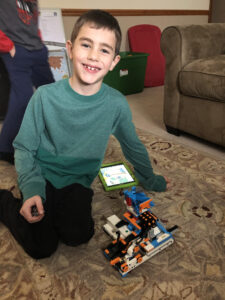
PC: GLCS
For families who want to be more involved in the education of their children, Gull Lake offers a part-time program. All courses are elective and have a virtual component, developed by Gull Lake teachers in collaboration with a community expert, as well as an optional application. Many full-time virtual GLVP students take elective classes through this program as do some students from the traditional programs. “I love the blurring of the lines and the diverse group of families we serve,” shared Cindy Fadel, director of the part-time program. Students from Kalamazoo County and contiguous counties can also enroll in this program.
The part-time/homeschool program is housed in an old Gull Lake elementary school in Bedford, a town between Gull Lake and Battle Creek. Every inch of space is utilized in the building including creative uses for storage. In addition to five classrooms, the building has a gym, library, and kitchen. Students self-checkout iPads and MacBook Airs from the cart in the office to use while at the facility, and can receive hotspot cards if they need them at home to complete their work. Parents stay with their children at the school or the Richland Area Community Center where some applications take place. Applications are designed to be hands-on and investigative and look like a one-room schoolhouse with students of varying ages/grades. Project-based courses like Creating Learning Through Music and Play are also offered.
Bridging that homeschool and public school experience together. This is very important to us as our children both attended public school for a long time. This was a huge transition for both of them. This takes the positive aspects of public school and meshes it perfectly with our homeschool program. ~GLVP Parent Feedback
GLVP encourages and helps facilitate cooperative partnerships between the school, community, business leaders, parents, educators, children, and families to provide engaging, personal learning experiences for students.
Gull Lake Early College
The Gull Lake Early College (GLEC) program is unique in the state as students can choose their own program. For example, a student may study health careers at KVCC while another pursues business or sustainable food systems. Students aren’t forced into one specific path at the college. GLEC also works with three different partners, Kalamazoo Valley Community College, Kellogg Community College, and Western Michigan University. A college advisor from each of the institutions is assigned to work closely with Gull Lake Early College staff and students. Every week, early college students connect with their early college mentor during seminar time at the high school and online through GLVP’s learning management system, GLOBE. Gull Lake’s staff devoted to early college mentoring include the college and career readiness classroom teachers, counselors, seminar teachers, and virtual mentors.
Gull Lake’s philosophy for structuring their early college program this way includes:
- allowing students to continue their personal educational goals.
- providing an opportunity for as many students as possible to attend college.
- providing an opportunity for as many career paths as possible.
- enhancing a culture of higher level learning in the district.
- having every student believe they can attend college.
- preparing students for college success.
- raising the bar for underclassmen.
In the past five years, enrollment has increased 81%. Over 280 students are in the GLEC program with 87 tenth-graders enrolling in 2021-22. Students are required to take an online Early College Capstone course for the duration of their 13th year. The capstone course walks a student through their first year of full-time college, month-by-month as the year progresses. During this year, students successfully demonstrate college and career readiness as they complete the program with an associate’s degree, certificate, 60 transfer credits, or a MEMCA certificate. (Gull Lake is a proud MEMCA program and participates in the MEMCA Data Project.) At the conclusion of Grade 13, students have a solid plan for the following year of employment or continued college coursework. Those who graduate from the Gull Lake Early College program receive an honor cord from the college they attended to wear at their high school graduation ceremony.
Gateway Academy
Gateway Academy is another program offered at Gull Lake to meet the needs of their students. For those who have had difficulty being successful in other programs, this alternative school offers more support to students. In addition to typical alternative school offerings such as individual course planning and a more structured setting, they also offer mental health services in the building, encourage participation in community service events, and teach life skills. Whether it’s receiving their diploma, being a productive citizen, or learning life skills, the staff has high expectations for all of their students.
In January 2017, Gateway moved into their new facility, located in the ground level of the administration building. The new home-atmosphere space is designed with room for learning and relaxing as well as access to a full kitchen and a washer and dryer. To learn life skills, students plan menus and prepare meals. Other life skills covered in the program include car maintenance, tax preparation, applying and interviewing for jobs, budgeting, and problem-solving. In addition to learning how to be healthy through eating, students have the opportunity to exercise regularly at the Sherman Lake YMCA each week. Gifts from a private donor make this possible.
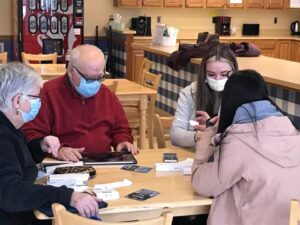
Teaching technology PC: GLCS Facebook page, Lynette Walker
Each student is required to complete 20 hours of supervised community service each year. Students have cleaned the Richland Township Cemetery, taught technology at the Richland Area Community Center, and donated at the Red Cross blood drive. Other volunteer works completed by students include bus cleanup, teacher assistant, making cards/ornaments for veterans, and serving at the Kalamazoo Gospel Mission.
Gateway uses Edgenuity curriculum on Chromebooks for online core and elective courses. Students also have the option to take non-essential courses through the Gull Lake Virtual Partnership. Reminders to specific students of assignments/projects due or notes of encouragement and congratulations are often posted on the chalkboard wall located in the commons area of the facility. To encourage students to further their education beyond high school, students visit area colleges and partner with local businesses to job shadow.
Gull Lake’s Gateway Academy provides a personalized option for students needing another approach to their education. They receive not just additional support for their learning and life-skills but learn in a close family atmosphere.
Through options and flexibility, Gull Lake is demonstrating their commitment to student-centered learning. Students who seek a personalized pathway for their education will find it at Gull Lake who is Graduating Leaders for today and tomorrow.
Author: Lisa Sitkins, President and CEO, LSS Connections and Consulting LLC, February 2022
